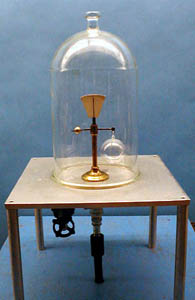Demos: 2A-08 Buoyancy of Air

A small balance supports a glass bulb on one arm and a balancing weight of much smaller volume on the other. A bell jar is placed over the apparatus and evacuated. The glass sphere now appears heavier, due to its greater loss of buoyancy.
Because this is an equal-arm balance, the equalization of torques in the balanced condition (in air) requires that
where the subscripts s and b represent the glass sphere and ball, respectively. Since the buoyant force depends only on the volume of air displaced, the buoyant force is greater on the glass sphere than on the metal ball. This means that ms > mb, which becomes evident when the buoyant force is absent.
Directions: Place the apparatus on the bell jar base and carefully adjust the balance. Then place the bell jar on the plate and turn on the vacuum pump. The glass sphere will move downward, indicating a larger mass. Opening the valve will restore the system to its initial balance.
Suggestions for Presentation: Refer to (or have available) an equal-arm balance. Ask what would happen to the balanced condition if you were push up on one side of the balance. Remind them that a normal balance assumes that the gravitational force is the only force affecting the balance. Introducing an additional force on one side upsets the balance. In the present demo, in addition to gravity, buoyant forces are also acting on the system unequally. Thus the larger object (the glass sphere in this case) has to have a larger mass to compensate for the larger buoyant force. When the air is removed, there is no longer a buoyant force, so the larger mass object will pull the balance arm downward on that side.
Applications: If extremely sensitive weighing of an object is required, unequal buoyant forces could affect the results.
Last Updated: Nov 30, 2023 11:25 AM